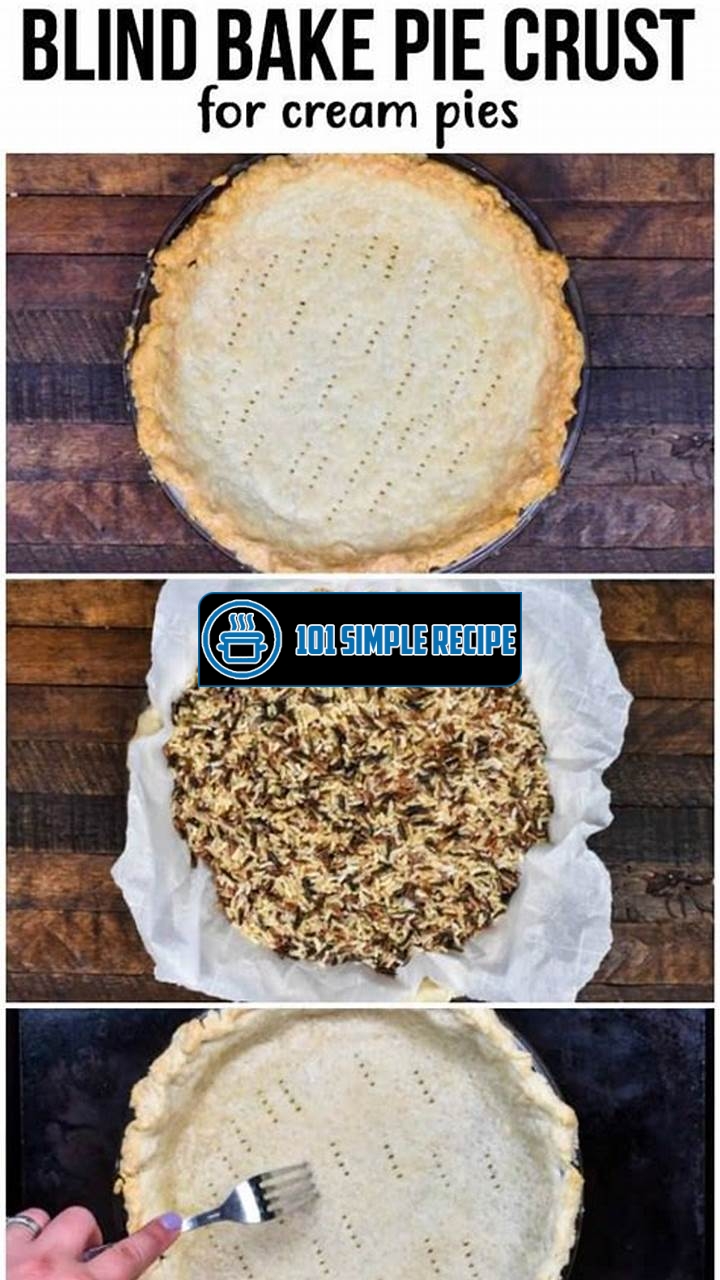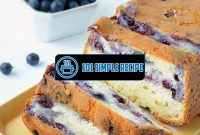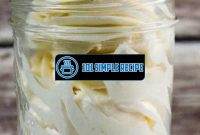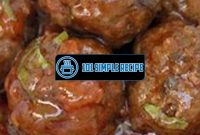In this article, you will discover the step-by-step process of blind baking a pie crust using rice. Blind baking, also known as pre-baking, is a technique used to ensure a crisp and flaky crust for pies with a liquid filling. Whether you’re a baking enthusiast or a novice in the kitchen, learning how to blind bake a pie crust can take your pie-making skills to the next level. So get ready to roll up your sleeves and embark on this culinary adventure !

The Benefits of Blind Baking
Blind baking is an essential technique for achieving a perfectly crisp and golden pie crust. By pre-baking the crust before adding the filling, you ensure that the crust is fully cooked and remains crisp, even after the filling is added. Let’s explore the benefits of blind baking in more detail.
Enhanced Pie Crust Texture
One of the key benefits of blind baking is that it enhances the texture of the pie crust. When you blind bake a pie crust, the heat from the oven causes the butter in the crust to melt. This creates steam, which in turn creates air pockets in the dough. As a result, the crust becomes light, flaky, and incredibly delicious. The golden color and delicate layers contribute to the overall enjoyment of the pie.
Additionally, blind baking allows you to control the texture of the crust. If you prefer a slightly softer crust, you can blind bake it for a shorter period of time. On the other hand, if you like a crisper crust, you can blind bake it for a bit longer. This flexibility ensures that your pie turns out exactly the way you want it.
Efficient Moisture Absorption
Blind baking also helps with moisture absorption. When you add a wet filling to a raw pie crust, the moisture from the filling can cause the crust to become soggy. By blind baking the crust, you create a barrier between the filling and the dough, preventing the filling from seeping into the crust. This allows the crust to remain dry and perfectly baked, providing a stable base for the filling.
Moreover, blind baking with rice provides an additional benefit when it comes to moisture absorption. Rice serves as a weight to prevent the crust from puffing up during baking. As the rice heats up, it effectively absorbs any excess moisture, resulting in a pie crust that is both crisp and dry.
Prevention of Soggy Bottoms
Soggy bottoms are a common issue when it comes to pie making. The bottom crust often ends up undercooked or mushy due to the moisture released by the filling. Fortunately, blind baking can prevent this problem. By partially or fully baking the crust before adding the filling, you ensure that the bottom crust remains crisp and holds its structure, even when faced with wet fillings.
Rice is particularly effective in preventing soggy bottoms. By placing a layer of cooked rice on top of the crust before blind baking, you create an additional barrier that prevents any liquid from seeping through. The rice absorbs the excess moisture, ensuring that your pie crust maintains its desired texture.
In conclusion, blind baking with rice offers numerous benefits when it comes to achieving a perfectly crisp and golden pie crust. It enhances the texture of the crust, allows for efficient moisture absorption, and prevents soggy bottoms. Incorporating this technique into your pie-making process will elevate your baking skills and impress your guests with delicious, well-baked pies.
Choosing Rice as a Blind Baking Medium
Rice is a popular and effective option for blind baking pie crusts due to several reasons. Not only does it serve as a heat conductor, but it also acts as a weighted medium. Additionally, rice is easily accessible and affordable, making it a convenient choice for many home bakers.
Rice as a Heat Conductor
When it comes to blind baking a pie crust, ensuring even heat distribution is crucial. Rice excels in this aspect as it is an excellent heat conductor. This means that when you use rice as a baking medium, it evenly distributes heat across the surface of the crust, helping it cook evenly.
An important point to note: Rice acts as a heat conductor, promoting even baking and preventing any unwanted undercooked or soggy spots in your pie crust.
Furthermore, the small size and shape of rice grains allow them to easily fill the empty space between the pie crust and the pie plate. This helps in maintaining the shape and structure of the crust during the blind baking process.
Rice as a Weighted Medium
Blind baking requires the use of weights to prevent the crust from puffing up or shrinking during the baking process. Rice serves as an excellent weighted medium that effectively holds down the pie crust.
By gently pressing the rice against the crust, it helps to maintain its shape while baking. This ensures that the crust retains its structure and doesn’t become misshapen or shrink in size. The added weight helps the crust maintain its original shape, allowing for a more professional-looking final product.
Another important point to consider: ⚖️ Rice acts as a weighted medium, preventing the dough from rising and shrinking during the blind baking process, resulting in a beautifully crisp and uniform crust.
Easily Accessible and Affordable
Accessibility and affordability are key factors when choosing a blind baking medium. Rice checks both of these boxes, making it a popular choice for home bakers.
Rice is a pantry staple that can be found in most households, making it easily accessible. Whether you have long-grain, short-grain, or even leftover rice, any variety can be used for blind baking. This versatility allows you to make the most of what you already have on hand.
Moreover, rice is a budget-friendly option. Compared to specialized baking beans or ceramic pie weights, rice is a more affordable alternative. This makes it an attractive choice for those who want to achieve fantastic blind-baked pie crust results without breaking the bank.
It’s worth noting: Rice is both easily accessible and affordable, making it a convenient and cost-effective choice for blind baking your pie crust.
In conclusion, rice is an excellent choice as a blind baking medium for pie crusts. With its heat conducting properties, weightiness, and accessibility, it ticks all the boxes required for a successful blind bake. So the next time you embark on blind baking a pie crust, consider reaching for the rice in your pantry and enjoy a perfectly baked crust every time!
Preparing the Pie Crust for Blind Baking
When it comes to blind baking a pie crust, proper preparation is key to achieving a crispy and evenly baked result. Follow these essential steps to ensure your pie crust is ready for the blind baking process.
Rolling Out the Pie Crust
Before you can blind bake your pie crust, you need to roll it out to the correct thickness. Start by lightly flouring your work surface and rolling pin to prevent sticking. Divide your dough into two equal portions to have enough for the top and bottom crusts.
Place one portion of the dough onto the floured surface and gently roll it out into a circle. Be sure to turn the dough occasionally and add more flour as needed to prevent sticking.
Tip: Roll the dough to a thickness of about 1/8 inch for a standard pie crust.
Crust Docking to Prevent Air Bubbles
After rolling out the pie crust, it’s important to dock it to prevent air bubbles from forming during the blind baking process. Docking involves creating small holes in the dough, allowing steam to escape and avoiding any unwanted air pockets.
You can use a fork or a docking tool to gently prick the surface of the crust. Make sure to evenly cover the entire surface to prevent any large air bubbles from forming while baking.
Tip: Docking the crust is especially important for recipes that require a pre-baked shell or a custard filling.
Chilling the Crust for Optimal Results
Before blind baking, it’s crucial to chill the pie crust to help maintain its shape and prevent shrinking during the baking process. Place the rolled-out crust into a pie dish or tart pan, gently pressing it against the sides and bottom.
Once the crust is in place, refrigerate it for at least 30 minutes to ensure it is thoroughly chilled. This will also help to enhance the flakiness of the crust when it’s baked.
Tip: For the best results, you can even chill your pie crust overnight before blind baking.
By following these essential steps of preparing your pie crust for blind baking, you’ll be well on your way to achieving a perfectly baked pie crust with rice that is golden, crisp, and ready to hold your delicious filling.
The Blind Baking Technique
Master the art of blind baking your pie crust to achieve a perfectly cooked and flaky base for your filling. Blind baking involves partially pre-baking the pie crust before filling it, ensuring that the crust is fully cooked and doesn’t become soggy when the filling is added. This technique is especially crucial for cream or custard-based pies that require a pre-cooked crust.
Using Parchment Paper and Pie Weights
One of the key steps in blind baking a pie crust is to prevent it from puffing up or shrinking during baking. To achieve this, start by preheating your oven to the recommended temperature mentioned in your pie recipe. Prepare the pie crust according to your recipe instructions, making sure it is rolled out and fitted into the pie dish.
To prevent the crust from bubbling or shrinking, line it with parchment paper. Gently press the parchment paper onto the crust, covering the entire surface. Next, fill the pie dish with pie weights or dried beans. These weights help to keep the crust flat and in shape during baking.
Place the pie dish with the weighted crust onto a baking sheet and transfer it to the preheated oven. Bake the crust for the recommended time stated in your recipe. The weights and parchment paper will help maintain the shape of the crust and prevent it from rising or shrinking excessively.
After the initial blind baking time is complete, carefully remove the parchment paper and weights from the crust. Return the crust to the oven to bake for a few more minutes to allow the bottom to brown evenly. Keep a close eye on the crust during this final baking step to prevent it from becoming overly browned or burnt.
The use of parchment paper and pie weights ensures that your pie crust bakes evenly and maintains its shape. It also prevents air bubbles from forming underneath the crust, which can disrupt the texture of your pie.
Proper Temperature and Timing
Blind baking requires precise temperature control and timing to achieve the desired results. Preheating the oven to the correct temperature is crucial for a well-cooked crust. Make sure to follow the recommended temperature in your recipe for blind baking.
The baking time will vary depending on the recipe and the type of filling you plan to add to your pie. Most blind baking processes take around 15-20 minutes, but it’s essential to check the recipe instructions for the specific timing.
During the blind baking process, it’s important to monitor the color of the crust. The crust should turn a light golden brown color, indicating that it has baked properly. If the crust starts to darken too quickly, reduce the oven temperature slightly or cover the edges of the pie crust with aluminum foil to prevent burning.
Remember, blind baking is just the first step in preparing your pie crust. Once it has cooled down, it’s ready to be filled with your desired ingredients and baked again according to your recipe instructions.
Monitoring and Adjusting the Crust
While blind baking your pie crust, it’s essential to keep a close eye on it to ensure it bakes evenly and doesn’t burn. Check the crust periodically to make sure it’s browning evenly and doesn’t develop any dark spots.
If you notice any areas of the crust puffing up during baking, gently press them down with the back of a spoon or fork to release the air. This will help prevent the crust from becoming uneven or misshapen.
Throughout the blind baking process, make sure to follow the recipe instructions and timing guidelines. Different recipes may require slightly different baking times and temperatures, so it’s crucial to adapt accordingly.
Once your pie crust has finished blind baking, remove it from the oven and allow it to cool completely before filling it with your desired ingredients. This cooling step ensures that the crust retains its structure and doesn’t become soggy when the filling is added.
To summarize: Master the art of blind baking your pie crust by using parchment paper and pie weights to prevent puffing and shrinking. Pay attention to the proper temperature and timing to achieve a perfectly cooked crust. Monitor and adjust the crust as needed to ensure even baking. With these techniques mastered, you’ll be on your way to creating delicious homemade pies with a perfectly cooked pie crust every time!
Finishing Touches
After blind baking your pie crust with rice, there are a few final steps to take to ensure that it is ready to be filled and enjoyed. These finishing touches will add the perfect touch of crispness and seal to your pie crust, enhancing the overall taste and texture of your pie.
Removing the Rice and Parchment Paper
Once your pie crust has been blind baked with rice, it’s time to remove the rice and parchment paper from the crust. Start by carefully lifting the edges of the parchment paper to release it from the crust. Slowly peel back the parchment paper, being cautious not to disturb the crust or break it apart.
Important: Make sure to remove all the rice from the crust. You can use a spoon or your fingers to gently scoop out any rice that may be stuck to the crust. This step is crucial to ensure that your pie crust is not only delicious but also visually appealing.
Egg Wash for Seal and Additional Crispness
An egg wash is a simple yet effective way to add a beautiful golden-brown color and extra crispness to your blind-baked pie crust. To make an egg wash, beat an egg in a small bowl until well combined. Then, using a pastry brush, carefully brush the egg wash all over the inside of the crust.
Pro tip: Be sure to pay extra attention to the edges of the crust, as they tend to be the most vulnerable to over-browning. Applying the egg wash evenly will create a seal on the crust, preventing it from becoming soggy when filled with your pie filling.
Cooling and Filling the Pie Crust
Once you have removed the rice and parchment paper and applied the egg wash, it’s time to cool your blind-baked pie crust before filling it. Allow the crust to cool completely at room temperature. This will prevent the filling from becoming too warm and causing the crust to become soggy.
Remember: Patience is key here. You want to make sure that your pie crust is fully cooled before adding your desired filling. Once cooled, carefully pour your favorite pie filling into the crust, ensuring it is evenly distributed. Then, follow the instructions for baking or chilling the pie according to the specific recipe you are using.
In conclusion, by following these finishing touches, you can ensure that your blind-baked pie crust with rice turns out perfectly crisp and ready to be filled. Remember to remove the rice and parchment paper, apply an egg wash for an extra seal and crispness, and allow the crust to cool completely before filling. With these steps in mind, you’ll be well on your way to creating delicious homemade pies every time.
Frequently Asked Questions
Here are some frequently asked questions about blind baking a pie crust with rice:
| No. | Questions | Answers |
|---|---|---|
| 1. | What is blind baking? | Blind baking is the process of pre-baking a pie crust before adding the filling. |
| 2. | Why do you need to blind bake a pie crust? | Blind baking ensures that the pie crust is fully cooked and prevents it from becoming soggy when filled with wet fillings. |
| 3. | Why use rice for blind baking? | Rice is often used as a weight during blind baking because it evenly distributes heat and prevents the pie crust from puffing up or shrinking. |
| 4. | Can I reuse the rice after blind baking? | Yes, you can reuse the rice for blind baking multiple times, as long as it hasn’t come into contact with any raw ingredients. |
| 5. | Can I use other grains or beans instead of rice? | Yes, other grains like dried beans or lentils can be used as a weight for blind baking. |
| 6. | How do I store the blind baked pie crust? | Once the pie crust has cooled completely, you can store it in an airtight container at room temperature for a few days. |
Thanks for Reading!
We hope you found this guide on how to blind bake a pie crust with rice helpful. Now you can confidently prepare pie crusts that are perfectly cooked and ready for your favorite fillings. Remember to visit our website for more delicious recipes and baking tips. Happy baking!
Jump to Recipe
Blind Baking a Pie Crust with Rice

Learn how to blind bake a pie crust with rice for perfectly cooked and crispy crusts. This method prevents the crust from becoming soggy when filled with wet ingredients.
- 1 1/4 cups all-purpose flour
- 1/2 teaspoon salt
- 1/2 cup cold unsalted butter (cubed)
- 1/4 cup ice water
- 1 cup rice (for blind baking)
- In a large mixing bowl, whisk together the flour and salt. Add the cold cubed butter and use a pastry cutter or your fingertips to quickly cut the butter into the flour until it resembles coarse crumbs. Gradually add the ice water, mixing it in with a fork until the dough starts to come together. Turn the dough onto a lightly floured surface and knead it a few times until it forms a smooth ball. Flatten the ball into a disk, wrap it in plastic wrap, and refrigerate for at least 1 hour.
- Once the dough has chilled, take it out of the refrigerator and let it sit at room temperature for a few minutes to soften slightly. Lightly flour a clean surface and roll the dough into a circle that is about 1/8 inch thick and larger than your pie dish. Carefully transfer the rolled-out dough to the pie dish, gently pressing it against the sides and bottom. Trim any excess dough hanging over the edges.
- Preheat your oven to 425°F (220°C).
- Place a piece of parchment paper or aluminum foil over the pie crust and fill it with uncooked rice, spreading it evenly to cover the entire surface. The rice will act as a weight to prevent the crust from puffing up or shrinking.
- Place the pie dish with the rice-filled crust in the preheated oven. Bake for 15 minutes, then carefully remove the parchment paper or foil with the rice. Return the crust to the oven and continue baking for an additional 5 minutes, or until the crust is golden brown and cooked through. Remove from the oven and let cool completely before filling with your desired pie filling.
- Once the pie crust has cooled completely, you can store it in an airtight container at room temperature for a few days.






